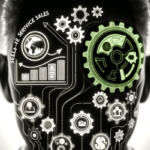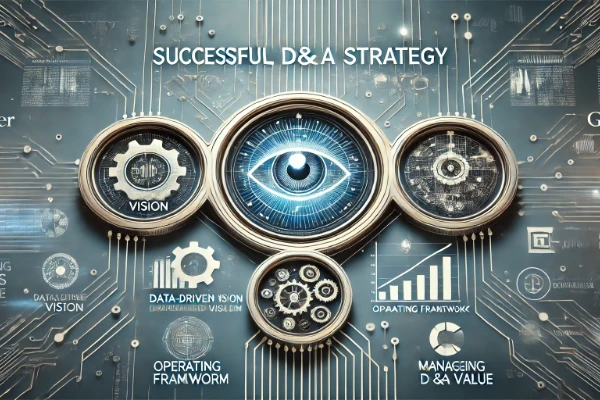
Pulling in the Perfect Marketer
January 2, 2024
Revolutionizing B2B: Embrace the Self-Service Sales Era
January 9, 2024My take from the Forrester Previsions 2024.
The Dawn of Generative AI in Business
Embracing the New Frontier: Generative AI in 2024 Generative AI’s emergence as a transformative force in 2024 is likened to the discovery of new worlds by ancient explorers. These explorers didn’t just seek new lands; they sought new possibilities, methods, and insights. Similarly, businesses today are not just adopting a new technology; they are embarking on a journey to redefine their operations, offerings, and customer interactions. The document highlights the socio-economic tension of the times – significant elections and the Olympics – reflecting a world on the cusp of significant change. Amidst this, generative AI stands as a beacon of progress and potential. However, this journey isn’t without its challenges. Just as explorers faced the unknown and unpredictable seas, businesses today grapple with the implications of AI on privacy, ethics, and employment. The text encourages a proactive stance, urging businesses not to wait on the shores of indecision but to dive into these uncharted waters, embracing both the immense potential and the challenges of generative AI. This proactive approach isn’t just about adopting new technology; it’s about leading a charge into a future where AI augments human creativity, decision-making, and interaction, creating a synergy that drives businesses and society forward. As we look to the future, it’s clear that generative AI will reshape the landscape of business and society. Yet, this future isn’t just something to be observed; it’s something to be actively shaped by today’s decisions and actions. The real question is, how will we navigate these waters? With cautious optimism? With bold determination? The choice is ours, and the time to decide is now.
Generative AI in Consumer Life
Seamless Integration: Generative AI in Daily Life In 2024, generative AI (genAI) has woven itself into the fabric of daily life, often without consumers even realizing it. The document emphasizes the paradox of the technology’s adoption: even skeptics use and love genAI, unaware of its pervasive influence. It’s not just a tool; it’s an integral part of our daily digital interactions. From Adobe’s generative fill function to Google’s Bard and AI-generated content on LinkedIn, genAI isn’t just present; it’s indispensable. However, this seamless integration brings its set of challenges and concerns. Consumers, while enjoying the benefits of AI, are also increasingly aware and cautious of its ethical implications and impact on human interaction. The text from the document echoes a significant sentiment prevalent in society: AI is not here to replace human thought and interaction but to augment it. This raises profound questions about the future of human-AI interaction. How do we maintain the human touch in an increasingly AI-driven world? How do we ensure that AI remains a tool for enhancement, not replacement? As businesses and consumers navigate this new landscape, the answers to these questions will shape not just the technology’s development but its integration into society. The trajectory of genAI is not just a technological journey; it’s a cultural and societal one, redefining our relationship with technology and each other. The true integration of genAI into daily life will be measured not just by how often we use it, but by how well it enhances, rather than diminishes, the human experience.
Boosting Creativity and Productivity
The Creative Catalyst: AI’s Boost to Productivity and Innovation The document presents a compelling picture of the future where generative AI acts as a catalyst for unprecedented productivity and creativity. It’s not just about automating tasks; it’s about liberating human potential. As AI takes over routine and repetitive tasks, humans are free to engage in more complex, creative problem-solving. This shift is profound, representing a fundamental change in how work is done and what it means to be productive. It’s not just about doing more in less time; it’s about doing more innovative and impactful work. The text suggests a future where interdisciplinary teams, continuous learning, and strategic alignment are the norm, all enabled by AI’s capacity to process and analyze vast amounts of data, learn from it, and generate insights. This future is not without its challenges. As AI reshapes the workplace, it also reshapes roles, identities, and career paths. It raises questions about the value of human work, the skills needed for future jobs, and how we prepare for a world where human-AI collaboration is the norm. The document doesn’t just present a vision of increased efficiency; it presents a vision of a more creative, innovative, and human-centric world where AI and humans work together to solve the most complex and challenging problems. As we stand on the brink of this new era, the question isn’t just how we will use AI to boost productivity and creativity; it’s how we will shape these technologies to reflect our values, aspirations, and the society we want to build.
Brand-Specific AI in Marketing
Tailored Success: The Rise of Brand-Specific AI in Marketing The document reveals a significant trend: the rise of brand-specific AI in marketing. It’s a shift from one-size-fits-all solutions to bespoke, tailored AI models that understand and embody the brand’s unique voice and values. This development marks a turning point in marketing, where personalization goes beyond the surface level, reaching deep into the brand’s core to create experiences and messages that resonate on a personal and emotional level with the audience. This trend reflects a broader shift in consumer expectations. In a world saturated with content and advertising, consumers seek authenticity, relevance, and personal connection. Brand-specific AI offers a way to meet these expectations at scale, providing personalized experiences without losing the brand’s essence. However, this approach also raises critical questions. How do brands ensure that their AI truly understands and aligns with their values and voice? How do they maintain control over a technology that learns and evolves independently? And perhaps most importantly, how do they balance personalization with privacy, ensuring that their use of AI enhances rather than undermines trust? The rise of brand-specific AI isn’t just a technological development; it’s a strategic imperative, reflecting the need for brands to be more relevant, responsive, and real in a rapidly changing world.
AI’s Hardware Challenges
Navigating the Bottlenecks: AI’s Hardware Challenges The document doesn’t shy away from the stark reality of AI’s development: the hardware bottleneck. As AI’s capabilities grow, so does its hunger for computational power. This demand has led to a race for GPUs and other AI-specific hardware, pushing the limits of production and availability. The result is a bottleneck that slows down the progress and scale of AI applications. This bottleneck isn’t just a technical issue; it’s an economic and environmental one. The cost of AI hardware makes it prohibitive for many, limiting who can participate in and benefit from AI’s development. Moreover, the environmental impact of producing and powering this hardware is significant, raising questions about the sustainability of current AI trajectories. The document points towards a future where these challenges are not just recognized but addressed. It suggests a pragmatic approach to AI, focusing on applications with clear ROI and sustainable practices. This approach reflects a broader understanding that the future of AI isn’t just about what’s possible technically; it’s about what’s viable economically, ethically, and environmentally. As we navigate this bottleneck, the choices we make will shape not just the future of AI but the future of our planet and society.
The Rise of Rapid Engineering Services
Engineering at the Speed of Thought: The Promise of Rapid Engineering Services The document introduces a future where rapid engineering services are the norm, enabled by foundational models and genAI in cloud services. This shift represents a significant leap forward, promising to speed up the development process and make it more accessible and flexible. However, the reality is more complex. Despite the hype, adoption is limited, reflecting the nascent stage of these services and the preference for in-house development to meet specific business needs. This gap between promise and reality reflects a broader trend in technology adoption: the balance between innovation and pragmatism. On the one hand, rapid engineering services offer a vision of a more agile and innovative future. On the other hand, businesses are cautious, balancing the potential benefits with the risks and uncertainties. This tension isn’t just about technology; it’s about how we approach change and progress. Do we leap at every new possibility, or do we take a more measured, strategic approach? The answer isn’t straightforward, and as the document suggests, the future of rapid engineering services will likely be a blend of both: a continued push towards faster, more flexible development, tempered by a pragmatic understanding of the needs, risks, and realities of business.
Backstage: The Leading Framework for Development
Simplifying Development: The Ascendancy of Backstage The document spotlights Backstage, an open-source developer portal created by Spotify, now a rising star in the development world. Its promise is simple yet profound: a single portal for all developer needs, from Git repositories to CI/CD pipelines, APIs, and infrastructure automations. The adoption of Backstage by major companies signifies a shift towards more streamlined, efficient, and developer-friendly tools and practices. This shift isn’t just about making life easier for developers; it’s about rethinking how development happens in the first place. It’s about breaking down silos, fostering collaboration, and building systems that are more coherent, cohesive, and capable of adapting to changing needs. However, as the document implies, this shift also raises questions about the future of development. How do we balance the need for standardization with the need for flexibility? How do we ensure that tools like Backstage enhance rather than constrain creativity and innovation? And how do we prepare developers and teams for a future where their work is increasingly facilitated by platforms and frameworks? The rise of Backstage isn’t just a technical development; it’s a cultural and strategic one, reflecting a broader movement towards more integrated, efficient, and agile ways of working.
Transforming Customer Experience
Revolutionizing Service: AI’s Impact on Customer Experience The document paints a picture of a future where generative AI has finally broken through in improving customer service for the first time in years. This breakthrough isn’t just about making service faster or more efficient; it’s about making it fundamentally better. AI’s role in this transformation is multifaceted. It enhances the capabilities of service agents, helping them respond more quickly, communicate more clearly, and solve problems more effectively. But it also raises significant questions. How do we ensure that AI-enhanced service remains personal and empathetic? How do we balance the efficiency of AI with the nuances of human service? And perhaps most importantly, how do we integrate these technologies into a broader customer experience strategy that values the customer as a whole person, not just a problem to be solved? The document suggests a future where AI is an integral part of customer service, but it also hints at a future where service is more human, more personal, and more connected. This future isn’t just about leveraging new technologies; it’s about reimagining what service means in an AI-augmented world.
Marketers as Privacy Champions
The New Guardians: Marketers as Privacy Champions In 2024, the document foresees a world where marketers aren’t just creators and communicators; they’re guardians of privacy. This role is a response to a landscape where privacy concerns are paramount, and trust is a critical brand asset. Marketers are increasingly involving privacy experts in their strategies and campaigns, reflecting a broader shift towards more ethical, responsible marketing practices. However, this shift isn’t without its challenges. The shortage of privacy experts, the complexity of privacy regulations, and the ever-present pressure to deliver results create a landscape fraught with challenges and contradictions. How do marketers balance the need for personalization with the need for privacy? How do they navigate the complex web of regulations and expectations? And how do they build trust in a world where skepticism and concern about data use are rampant? The document suggests a future where marketers are not just the voice of the brand but its conscience, navigating these complex waters with a mix of creativity, strategy, and ethical commitment.
Generational Shifts in B2B Purchasing Preferences
The New Decision-Makers: Understanding Millennial B2B Buyers The document highlights a significant shift in the B2B landscape: the rise of millennial buyers. These buyers bring a new set of preferences and expectations, valuing personal interactions with product experts and transparency in the buying process. This shift isn’t just about changing demographics; it’s about changing values and priorities. As millennial buyers become more influential, they’re reshaping the sales process, demanding more information, more authenticity, and more engagement. This shift presents both challenges and opportunities for vendors. On the one hand, it requires a rethinking of sales strategies and processes. On the other hand, it offers a chance to build deeper, more meaningful relationships with buyers. The document suggests a future where B2B sales are more personal, more consultative, and more aligned with the values and needs of a new generation of decision-makers.






